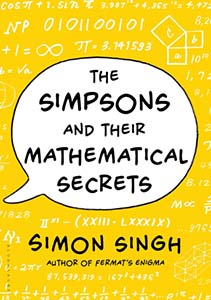Last year was the show’s 25th anniversary and luckily I got this fascinating book completed before the year ended. Even the most jaded critic who says, “Oh, the show was better back during [insert season here],” will enjoy the observations and explanations Singh reveals from the show’s lengthy run. As a bonus, there’s two chapters dedicated to Futurama which is even more rife with uber-nerdy jokes.
Since we don’t have cable and I only follow The Simpsons 10 years later through DVDs, I discovered the book courtesy of the podcast Inquiring Minds when the author was a guest. Little did I remember, he had been also on On The Media but for another book called Trick or Treatment: The Undeniable Facts About Alternative Medicine. Singh and his co-author were dragged through the UK’s outdated libel/slander laws for pointing out the bullshit in alternative medicine (chiropractors, acupuncture, homeopathy and herbal remedies). Thankfully, the other book helped become a factor in reforming the UK’s laws because the bar was too low and that nation was a favorite venue for the thin-skinned and professional con artists (Scientology namely).
Back to the Simpsons.
Singh blows through the quick history bringing the show to life and jumps quickly to the key writers who have Mathematical backgrounds…Al Jean and Mike Reiss. While Groening was a cartoonist and James L. Brooks brought in sitcom vets, Jean & Reiss became the first try show runners until the reins were handed over to David Mirkin. The duo sprinkled in the jokes pretty early if you remember the first regular episode “Bart The Genius.” It laid down the precedent continuing to this very day. Thanks to the show and Singh, I now understand and dislike SABRmetrics even more.
It really picked up in the last act, Futurama because this show’s primary writing staff was composed of science graduates: namely David X Cohen and Ken Keeler. Of course Cohen having written for The Simpsons and Beavis and Butt-head helped. Keeler’s run with David Letterman and The Critic weren’t anything to blow off. The most intriguing joke and concept I finally understand is how there can be more than one infinity. If you remember in “Raging Bender” the gang goes to the movies at a Loew’s Aleph-Null Plex. Probably not. I too didn’t understand the aleph-null symbol, infinity is represented by a figure eight lying on its side for me. When I watched the episode again with the commentaries, Cohen explained it yet I thought he said “olive-knot,” keeping me in the dark for many years. Singh explains in plain English; aleph-null represents infinity if you use whole numbers (0, 1, 2, 3…). Aleph-one represents the infinity between zero and one which is larger than aleph-null. Now I understand what scientists mean when they’re discussing different types of infinity. I always thought infinity covered it, there’s no real, practical difference. Oh yeah, I also understand the significance behind 1729. For that, you need to read the book.
Are Singh’s findings for everybody? Probably not. It’s still intriguing and maybe it could serve as inspiration to help motivate kids who hate math. I loved math. I just had trouble understanding how to apply much of it beyond Algebra II.

